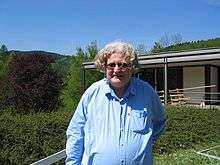Jens Carsten Jantzen
Jens Carsten Jantzen (born 18 October 1948, in Störtewerkerkoog, Nordfriesland) is a mathematician working on representation theory and algebraic groups, who introduced the Jantzen filtration, the Jantzen sum formula, and translation functors.

Jens Carsten Jantzen
In 2012 he became a fellow of the American Mathematical Society.[1]
Publications
- Jantzen, Jens Carsten (1979), Moduln mit einem höchsten Gewicht, Lecture Notes in Mathematics, 750, Berlin, New York: Springer-Verlag, doi:10.1007/BFb0069521, ISBN 978-3-540-09558-3, MR 0552943
- Jantzen, Jens Carsten (1983), Einhüllende Algebren halbeinfacher Lie-Algebren, Ergebnisse der Mathematik und ihrer Grenzgebiete (3) [Results in Mathematics and Related Areas (3)] (in German), 3, Berlin, New York: Springer-Verlag, ISBN 978-3-540-12178-7, MR 0721170[2]
- Jantzen, Jens Carsten (1996), Lectures on quantum groups, Graduate Studies in Mathematics, 6, Providence, R.I.: American Mathematical Society, ISBN 978-0-8218-0478-0, MR 1359532
- Jantzen, Jens Carsten (2003) [1987], Representations of algebraic groups, Mathematical Surveys and Monographs, 107 (2nd ed.), Providence, R.I.: American Mathematical Society, ISBN 978-0-8218-3527-2, MR 2015057[3]
- with Joachim Schwermer: Algebra, Springer-Lehrbuch, Springer-Verlag, 2006, doi:10.1007/3-540-29287-X, ISBN 978-3-540-21380-2
- with Walter Borho: Borho, Walter; Jantzen, Jens Carsten (1977). "Über primitive Ideale in der Einhüllenden einer halbeinfachen Lie-Algebra". Inventiones Mathematicae. 39: 1–53. doi:10.1007/bf01695950.
gollark: Those are not mutually exclusive.
gollark: Which is about 3 years.
gollark: It would take 1000 days to pay off based on your $12 a day figure, ignoring electricity.
gollark: Is hilariously slow, and your device probably still has a GPU even if it's just doing video output.
gollark: Says the person whose browser IS RENDERING ON A GPU!!!!!¡!!¡¡¡¡¡
References
- List of Fellows of the American Mathematical Society, retrieved 2013-01-26.
- Vogan jr., David A. (1985). "Review: Einhüllende Algebren halbeinfacher Lie-Algebren, by Jens C. Jantzen" (PDF). Bull. Amer. Math. Soc. (N.S.). 12 (2): 279–283. doi:10.1090/s0273-0979-1985-15380-7.
- Donkin, Stephen (1989). "Review: Representations of algebraic groups, by Jens Carsten Jantzen (1987)" (PDF). Bull. Amer. Math. Soc. (N.S.). 20 (2): 211–215. doi:10.1090/s0273-0979-1989-15768-6.
External links
- home page of Jens Carsten Jantzen
- Jens Carsten Jantzen at the Mathematics Genealogy Project
- Pictures from Oberwolfach
This article is issued from Wikipedia. The text is licensed under Creative Commons - Attribution - Sharealike. Additional terms may apply for the media files.